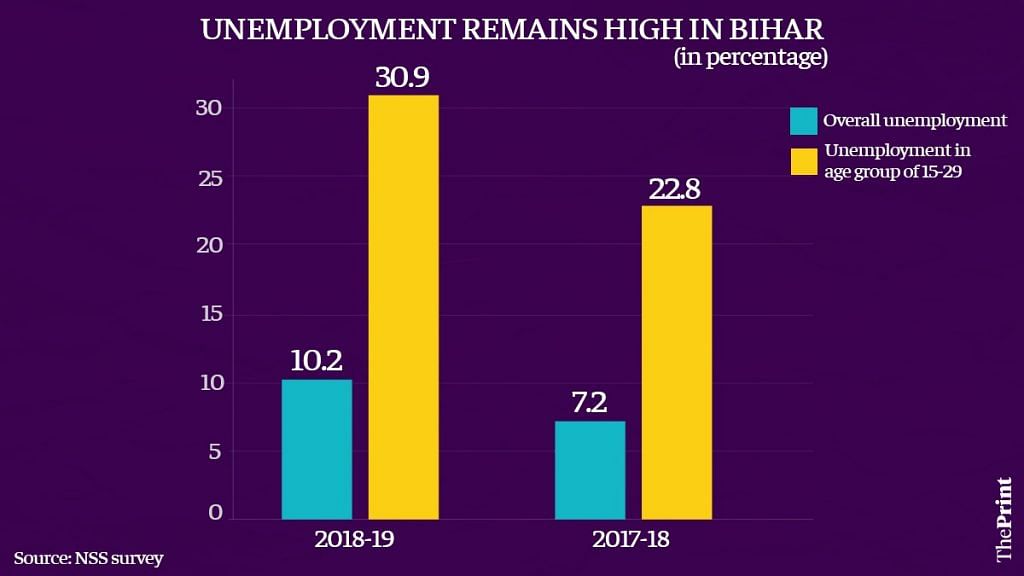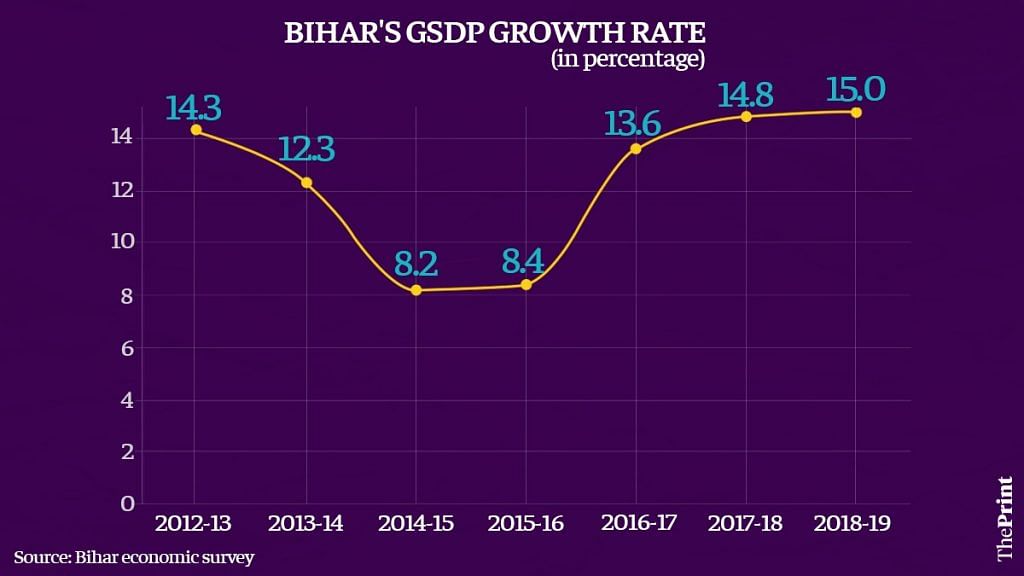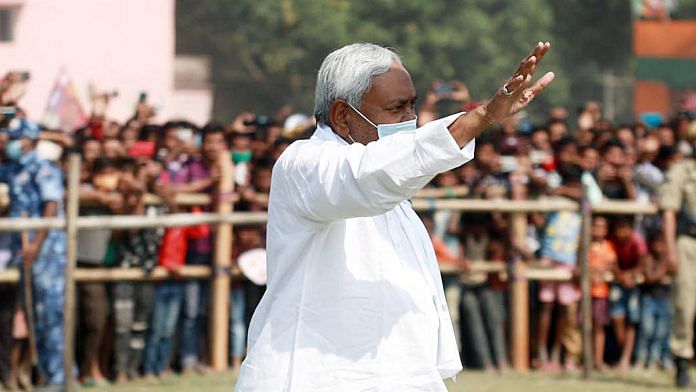New Delhi: The Tejashwi Yadav-led Rashtriya Janata Dal emerged as the single largest party in the Bihar assembly elections, but its alliance, the Mahagathbandhan, fell short of dislodging the ruling National Democratic Alliance from power.
One of the reasons being attributed to 31-year-old Tejashwi’s strong showing is his connect with the youth, and the RJD’s promise to provide 10 lakh jobs if voted to power. This probably reflects the biggest challenge for JD(U)’s Nitish Kumar when he takes the chief minister’s chair for the seventh time in all.
Nitish’s ally BJP too had promised 19 lakh jobs if the NDA comes back to power, which goes to show just how much of a problem unemployment has been in Bihar. While the state’s economy has grown in double digits in the last few years, unemployment continues to rise, especially after the Covid lockdown, when many labourers who had migrated to other states returned to Bihar.
Adding to the development challenge facing Nitish Kumar is Bihar’s low per capita income, and the fact that nearly one-third of the population lives below the poverty line.
This year, the entire Indian economy is likely to contract by double digits on account of the pandemic and its economic impact. Bihar’s economy will thus feel the pinch too.
Also read: In Bihar, BJP likely to get more cabinet berths but Nitish Kumar will be CM
The problem of jobs
Data from the National Sample Survey showed that Bihar’s unemployment rate rose in 2018-19 to 10.2 per cent, as against 7.2 per cent in the year-ago period. At the same time, the overall unemployment rate for the entire country fell to 5.8 per cent from 6.1 per cent the year before.
But more worryingly, the data showed that Bihar had one of the highest unemployment rates in the age-group of 15-29 years — 30.9 per cent in 2018-19, as against 22.8 per cent in the year-ago period.
This data point could have worsened in subsequent years.

Political analyst Manisha Priyam told ThePrint: “Unemployment is a challenge and has been a challenge. There will be pressure to provide jobs. Tejashwi Yadav promised 10 lakh jobs but Prime Minister Narendra Modi promised 19 lakh jobs. And this time, the Mahagathbandhan will have a very strong presence in the House, having won nearly half the seats.”
Priyam pointed out that the state’s own revenue comprises only one-fourth of the expenditure requirements in Bihar.
“Bihar is dependent on central grants and devolution from the divisible pool. So for any massive job creation efforts, it will have to fall back on the central government,” she said, adding that some of the poorest districts like Purnea have voted for the NDA, indicating that the people still have high hopes from Modi and Nitish.
Also read: Nitish Kumar — ‘political wizard’ with no solo election win set to become CM 7th time
Poverty and low per capita income
In 2011-12, Bihar remained one of the poorest states in the country, with 33.7 per cent of its population below the poverty line.
Economists and analysts say though there may have been some improvements in the subsequent years, demonetisation and now the Covid-19 pandemic may have pushed more people below the poverty line.
Shaibal Gupta, founder member secretary of the Asian Development Research Institute (ADRI) in Patna, said demonetisation was like a “monetary Covid” that may have increased poverty levels in the state.
Care Ratings, in a 30 October report, estimated that the per capita GSDP of Bihar was at Rs 46,664 in 2019-20, only 35 per cent of the national average of Rs 1,34,226. In 2011-12, its per capita GSDP was at 34 per cent of the national average, reflecting negligible improvement, despite the fact that the state’s economy grew at a faster pace than the overall Indian economy.

“Bihar remains one of the most populous states with the lowest per capita income. A lot needs to be done to lift the economy to a higher level,” the report said.
Manufacturing could be key for job creation
The Care Ratings report also pointed out that Bihar has a low share of India’s factories — only 1.5 per cent as of 2017-18 — and will need to improve.
“This is a fallout of the lower share of manufacturing in GSDP, given that manufacturing has the potential of attracting higher investment, which in turn generates more employment… The government needs to focus on providing the right incentives to enable the same,” the report said.
In Bihar, the share of manufacturing in the total GSDP was as low as 8.7 per cent, while the all-India figure was 17.4 per cent.
U.K. Sinha, former chairperson of SEBI, wrote in The Indian Express that while agricultural production has shown encouraging improvement, Bihar does not manufacture anything of consequence.
“Poverty continues to be high and unemployment much above the national average. The manufacturing sector’s contribution to Bihar’s economy is just 8.7 per cent of the national average. Data for 2017-18 shows that a mere 1.5 per cent of the nation’s factories are registered in Bihar; the needle on fixed capital formation has remained static on 0.6 per cent for over a decade. FDI in the state in 2019-20 was a mere 0.01 per cent of the national average, and Bihar’s rank in ease of doing business was 26 in 2019,” Sinha wrote.
ADRI’s Gupta added that finance is going to be an important challenge for the Bihar administration, more so post Covid.
“You need money to provide bijli, sadak and paani (electricity, roads and water). Private sector investment can create employment, but for that again, there has to be some initial investment from the government,” he said.
Also read: Despite the sweet victory, Modi-Shah BJP has a Nitish Kumar-sized problem in Bihar







The problem of Bihar is its huge and growing population. And high illiteracy rate coupled with unskilled labour. No government can take Bihar out of poverty as long as people continue to multiply manifold.
It is good that Nitish is now weaken CM and dependent on BJP, whether CM or PM the weaken or dependent leader has beenvery good on economic front and reform, a strong CM or PM get a bigger aspiration/ ambition and indulge into self branding and image creation and start doing lot of other things that leverage doesn’t exists in a dependent and coalition govt so what ultimately a weaken CM or PM do they do focus on common growth agenda and economic reform. Nitish was a very abled CM until sometime 2012 from there some media and so called intellectual started projecting him Modi challenger thats when he distracted from Bihar development and indulge into indirectly with bigger ambition in national politics. It is good that now he should knows that this is his last chance to any big impact on Bihar politics, with supportive Modi govt at center can accelerate economic and development agenda because more than anyone else BJP need to keep Bihar in their side, Nitish has limitation and his politics is over this is the last chance for him as CM.